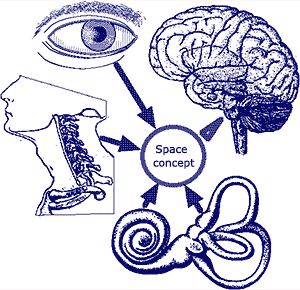Equilibrium - what is it?
Throughout species evolution, the human being has obtained together with some other superior primates, certain features which differentiate men from some others, one of them is that of walking straight on the legs, i.e. being bipedestrian.
Equilibrium sensations are known as equilibrium sense, i.e. the spatial orientation and the regulation of it in the space produced by this sensorial system, among which there are the vestibular receivers (ear), the propioceptive receivers of skeletal muscles and articulations, as well as skin receivers.
These are interconnected in the brain stem and in the brain cortical areas with the visual structures including nucleus controlling ocular muscles, auditory via and the cerebellum reflex center.
This is the way how the conscious equilibrium sensation is produced which is differentiated from the unconscious reflex regulations.
The equilibrium center must receive information from the environment in order to be able to establish which particular position the body must assume. To this end, it uses information coming from:
|
Eyes |
Visual Information |
|
Ears |
Vestibular and Auditory Information |
|
Articulations |
Proprioceptive Information |

The eyes indicate position of the visual horizon, that is to say, relationship between the body and the floor. Thus, it is possible to know whether it is an inclined plane, an abysm, etc.
Ears in their vestibular portion, register the different lineal and rotatory accelerations and deaccelerations, to which men are daily exposed. In their auditory portion, the ears register a sound in order to support the suitable position in line with the origin of the registered sound.
Articulations detect deep tactile sensations depending on the position where they are located.
Eyes, ears and articulations (peripherical sensorial organs) send their respective information to the equilibrium center by which it is processed and which is able to give a right answer or one of perfect equilibrium.